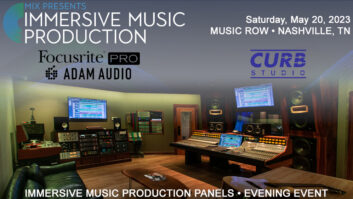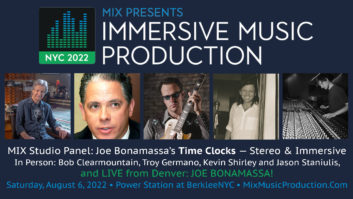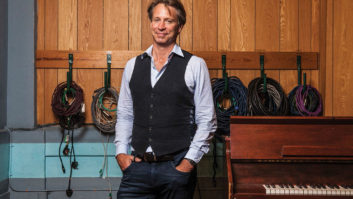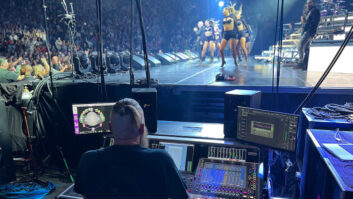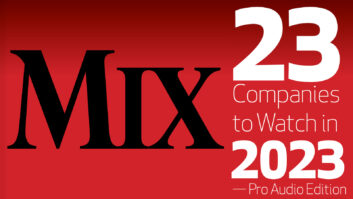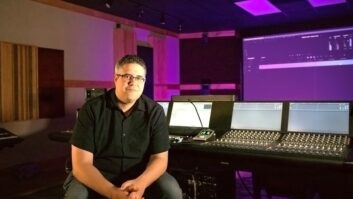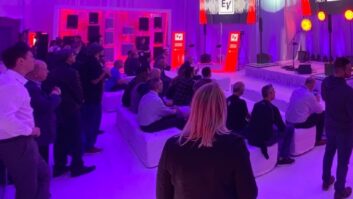
Immersive audio is nothing new. Heck, binaural technology was first demonstrated publicly way back in 1881, in France. But over recent years, we’ve entered something of a Golden Age of immersive audio as 360° or 3D playback has become more prevalent in cinema, videogames, virtual reality, broadcast television, live performance events and, more recently, music recordings.
The technology companies at the forefront of this latest era of immersive audio are well known by now, and include Fraunhofer IIS, Dolby Laboratories, DTS, Dirac, THX and others. But while much of the focus has been on 3D music playback over loudspeakers for many applications, whether in commercial venues or the home, the Holy Grail for tech and media companies is the ability to deliver a compelling spatial audio experience to headphone listeners. There are, after all, more than 5 billion smartphones in use around the world, according to an ITU estimate. This is a market yet to be conquered by immersive media companies.
ORBITAL AUDIO
The lack of broader uptake by mobile consumers of some of the new immersive music formats could perhaps be attributed to the limited number of distribution services on which they are available, or the need for specialized codecs. With that in mind, multi-Grammy Award-winning artist and producer Ricky Martin recently re-released his Pausa EP in a “Headphone Edition” that features songs remixed in an immersive process dubbed Orbital Audio. Martin’s songs are the first in the world to be released with Orbital Audio processing.
Martin says that his search for a way to add a new dimension to his music was inspired by the coronavirus pandemic. Indeed, his initial focus was on healing, which is still central to the business plan of his new company, Martin Music Lab, which launched Oct. 8. “Everybody told me, no more concert tours,” says Martin. “I said, what do you mean? That’s all I’ve been doing since I was 12 years old. I was dealing with a lot of anxiety.”

Having listened to many examples of immersive music, Martin says, he wanted to make Orbital Audio “perfect.” In late July, with the release of the new version of Pausa, fans got to experience the patent-pending process that Martin has developed in collaboration with multi-Grammy Award-winning engineer Jaycen Joshua and his mix assistant, Michael Seaberg. Understandably, the team is keeping their new tech under wraps, but the results can be heard on the release: voices and instruments pan and circle a listener’s head, adding spaciousness and dynamism to the mix.
“I wanted to create a very individual and unique way to make these instruments fly around our heads,” says Martin, “but more importantly, to make it available to everyone.”
AvidPlay App Adds DIY Dolby Atmos Music Distribution
The process delivers a binaural file, which means that it can be distributed over any streaming service or platform without requiring the user to download and install a codec or special app. Orbital Audio is “software-based with a hardware decoding aspect,” says Seaberg. “We are mainly a software-driven company, and that’s how we create our products, but there could be third-party hardware involved to allow different platforms access to the experience.”
Indeed, this is not like the 4D format, with which some electronic artists have been experimenting, or 8D, which adds reverb and panning to a mastered stereo release to create a spatial experience. That said, there is a reverb component to the process. “We did my album with Orbital Audio, dealing with the limitations. I use a lot of reverb in my recordings,” says Martin, “but if you go into a studio with Orbital Audio in mind when you start recording, and you keep it as dry as possible, the experience is going to go to another level. Now when we go into the studio, we think about Orbital Audio every time we record any instrument.”
On Oct. 10, World Mental Health Day, Spotify reported that playlists focused on mental health saw a 50 percent increase in listening time globally. The platform also reported a 122 percent rise in streaming hours of podcasts focusing on self-help and mental health. That’s hardly surprising given the constant barrage of stress- inducing news that 2020 has delivered. It also brings us back to Orbital Audio’s original focus. “We want to work with wellness apps—we might even create a wellness app—and create a therapeutic aspect. This could become very therapeutic for people with Alzheimer’s, PTSD, brain tumors,” says Martin, who believes that coronavirus pandemic-related PTSD may eventually emerge.
Meanwhile, in just the short time since it was introduced, Orbital Audio has been attracting interest among music artists and mixers. “We have 10 engineers in Los Angeles and we’re going to have engineers in New York, Puerto Rico and Miami. The idea is for this to go global,” says Martin. The company is actively recruiting mixers. “Jaycen’s reaching out to his connections and Ricky is reaching out to his connections,” says Seaberg, “and people are reaching out to us, because of the publicity.”
Artists including Bad Bunny and Residente, who both appear on the Pausa EP, as well as A$AP Rocky and Myke Towers, are said to be interested in releasing music using the Orbital Audio process. Producer Rodney Jerkins, record exec Chris Taylor and Noah Assad, Bad Bunny’s manager, have reportedly joined Martin Music Lab’s executive advisory board.
“I can’t wait for Sting to get his hands on this. I know he’s going to bring some crazy sounds to the catalog of the Police or his own music,” says Martin of another of his Pausa collaborators. “We’re going to tap into some crazy catalogs that are going to be exciting to experience in Orbital Audio.”
AUDIBLE REALITY

Audible Reality, an audio app for iOS and Android that launched Aug. 31, enables fans to listen to streaming music in 3D through the application of custom profiles or presets called “Vibes.” The service is the brainchild of Matthew Boerum, company founder and CEO, an award-winning audio engineer, musician, educator and Ph.D. candidate at Montreal’s McGill University. He has the backing of musicians including mega-producer Teddy Riley and Semisonic songwriter and producer Dan Wilson.
For listeners, the app offers a selection of free Vibes with names like Sparkle, Groove and Elevate that do pretty much what their titles suggest. A Smart option uses AI to optimize any track. For the moment, Vibes may be applied to anything streaming on Spotify or that lives on the user’s phone—in iTunes, for instance.
But the company’s Central idea is for artists to create their own Vibes using the Audible Reality Pro immersive, interactive mastering tool for their DAW and make them available for sale through the platform. Audible Reality’s Dashboard allows artists to set release dates, digital service provider distribution and Vibe permissions and pricing, and provides sales and performance analytics.
As Wilson told Forbes, “It can really put the different instruments into wildly different sonic spaces. I can make a guitar sound like it’s coming in from behind your head, or I can make it sound like it’s on a mountain or in a closet.” As he also noted, the Vibe he created for Semisonic’s new EP, released Sept. 18, might not enhance, say, an Ariana Grande song. “But it sounded great on Jack Johnson.”
For artists, the Audible Reality Pro plug-in is available through a three-tier monthly subscription plan that ranges in price from $8 to $16. The company recommends that artists sell Vibes at $0.99 to $1.99. Income is split between the artist and the service.
SANA360
Anyone who attended any gigs in the London area during the 1970s and ’80s will be familiar with UK rock concert promoter Straight Music and their iconic show posters. The brand is back with Straight Music Presents, a collaboration between several renowned rock photographers, record executives and Emmy- and Grammy-winning producer Jay Rifkin, who has developed Sana360, an immersive technology for a more specialized market: music releases on vinyl.
Described by the company as “spatial re-creation technology,” Sana360 is being applied to rare live recordings from Straight Music’s heyday. On Sept. 24, Straight Music Presents released two limited-edition double LPs, from The Clash and the Sex Pistols, and has promised future releases from Blondie, The Cure, Cocteau Twins, The Ramones and Talking Heads.

In a company statement, Rifkin said, “We could move sound around the room and do all kinds of tricks, but that’s not what music lovers want. People want an authentic experience. They want to feel like they are there, a sense of place. We strive to match each individual performance to the venue it was originally performed in, transporting the listener into a virtual live music experience.”
According to the statement, “Sana360 is a proprietary process developed specifically for mastering and remastering a broad range of music content. The multi-stage process produces a spectral balanced, enhanced, and immersive sound field from almost any musical input, including mono recordings. Every Sana360 mastering is a unique result of a proprietary process and technologies, combined with experienced audio professionals who closely monitor every Sana360 stage.”
Approaches to bringing the immersive audio experience to music listeners continue to proliferate, and doubtless the already entrenched leaders in the field will continue to expand and evolve their offerings. As the number of options available to artists and engineers continues to grow, ultimately it’s the consumer who will benefit from this rapidly evolving field.
Audible Reality • www.audiblereality.com
Straight Music Presents • www.straightmusicpresents.com
Pausa (Headphone Edition) • https://spoti.fi/33SnQpA
